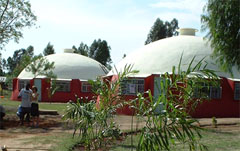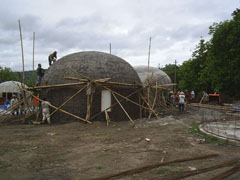Domes For The World Foundation Asks You to Help
Updated January 23, 2007
by Rebecca South
 |
|
The DFTW Foundation is a Nonprofit Corporation. Donations are tax deductible. |
|
P.O. Box 520220 |
Domes For The World Foundation Mission Statement
The Domes For The World Foundation's mission is to improve the lives of people worldwide through the introduction and construction of Monolithic Domes and EcoShells for personal and public use. We will initiate and coordinate efforts to alleviate storage, shelter and housing shortcomings in struggling cultures and impoverished lands. We will seek out grants and donations to fund construction of permanent, affordable, sanitary, and safe structures for those who have none. We will train local peoples in our methods of construction and transfer our technology.
The Need
In countries such as the Union of South Africa, Korea, Mexico, Ghana, Philippines, Honduras and others, the need for low-cost housing is staggering. Reported housing shortages range from 500,000 to 1,000,000. Can you imagine the effort it takes to initiate a project for 1,000, 10,000 or 100,000 units? Example: Building 25,000 homes in a timely manner, with a goal of 20 completed units per day, for 250 days per year, requires 5 years.
The logistics are enormous and the financing presents another problem. In many areas, families must maintain themselves with an annual income that wouldn’t pay an average dry-cleaning bill. Fire is also a danger, and fire protection usually is limited. Other hazards impinging on quality housing include earthquakes, hurricanes, rot and decay.
Our Solution
The UN has set guidelines for what they deem to be adequate housing. We have built a prototype home at the Monolithic headquarters meeting their requirements. It is a simple, 28-square-meter (314 square feet) house which utilizes approximately $1000 worth of basic material. This (EcoShell) concrete steel-reinforced dome measures 6 meters (20 feet) in diameter and 3 meters (10 feet) in height. It consists of openings for a door and window in front and two small windows in the rear.
Cost
For this example, we are assuming there is some sort of existing infrastructure near the building site. The cost of extending simple roads, simple water, simple sewage with sewage treatment, including land costs will run approximately $2000 per unit. We add $1000 per unit for the raw cost of the structure. That includes the Airforms. (Since we expect to build one hundred homes using one Airform, the project will require ten Airforms at $3,000 each). To that, we add $2000 for interior finish, appliances, basic equipment and general overhead. A thousand units, therefore, will cost around $5 million.
Details
Before construction of homes commences, a crew will build the infrastructure. Next, the foundations and floors will be built; followed by a crew to inflate the Airforms and apply the reinforcing steel; followed by a crew to apply the concrete; followed by a crew to finish the doors, windows, and exterior coatings; followed by a crew who will finish the structures.
If five homes are started per day and if work proceeds without interruption, 1,500 families will have superior homes in 300 days. If we allow one-third of the time for interruptions, a 1000-dome project, at three homes per day, will take about a year.
Training
The results will include trained personnel able to continue constructing and train even more workers. Monolithic does not give exclusive rights to any individual or entity. The technology is for everyone that desires to learn it. The same techniques utilized to construct the housing units can be employed to build bridges and culverts.
Current Projects
In the Hyderabad desert of India, Catalytic Software, Inc. has constructed an entire town of EcoShells to house software engineers, recreations centers and offices. In Nigeria, World Youth International has finished an orphanage built of EcoShells. In Haiti, Double Harvest recruited local laborers to help build an EcoShell home with the hopes of having the technology catch on.
EcoShells are being constructed in areas striken by the Tsunami. Recently, the President of India visited such a home during it’s construction and is calling for more.
Things are happening, but they need to happen faster.
Sustainability and the Future
Sustainable buildings, according to the U.S. Green Building Council, save energy, water and materials; preserve the local surroundings; assure the health of their occupants; and require little maintenance.
Mr. Perry Gray-Reneberg, professor of industrial technology at Humboldt University, says, “Monolithic Domes [and EcoShells] inherently resist the wasting of more precious resources in that they sustain human life and protect our considerable investment of time. We work to build, commune with nature and one another, and thrive as a culture and society. If our structures are no sanctuary from stray bullets, indiscriminate winds, devouring insects, or raging fires, then they are not sustaining. Monolithic Domes [and EcoShells] demand our labor once to assure the security of ten generations to follow. Building for the future involves community-wide effort to educate public servants and economic leaders with what our grandchildren will have as common sense: Monolithic Domes [and EcoShells] sustain all communities of Earth.”
Technology has thankfully shrunken our world to the extent that we can no longer ignore the plight of our neighbors and has given us the means by which we can take care of each other better. We must do that. There is really no other option.
Much of the world’s housing problems are solved by utilizing EcoShells and Monolithic Domes. Grants, sponsors, endorsements, spokespersons and/or endowments must be found to make that dream a reality. You can help today with an online donation. Every dollar helps.
Related Links:
- Domes For The World Website @ www.dftw.org
- Make a Donation Now
- PDF Update January 2007
- The Monolithic Dome
- Southern Sudan Education Project and Manute Bol Raise Funds for EcoShell School in Yomchiir
- EcoShells Round the Corner
- Ecoshells vs. The Monolithic Dome
- EcoShell I Construction
- The Monolithic Construction Process
- Mapping It Out-- Monolithic Domes Cover the World
- Index of Larger Monolithic Dome Projects -- Partial List In Alphabetical Order by State
- Tsunamis -- Rebuilding Better After Disaster
- Change the World Ministries Constructs Orphanage
- Owiti Children's Home Gives Hope to Very Needy Children in Kenya
- World Youth International Owiti Children's Home -- Now Open
- Solid House Foundation
- Surf City Cabins - Costa Rica
- Progress on the Owiti Children's Home And Medical Centre
 Think Round, The Story of David B. South and The Monolithic Dome
Think Round, The Story of David B. South and The Monolithic Dome  Brand
New Information Pak and Video!
Brand
New Information Pak and Video!
177
Dome Park Place - Italy, TX 76651
Tel (972)483-7423 - Fax (972)483-6662
![]() | Press Room
| Press Room
